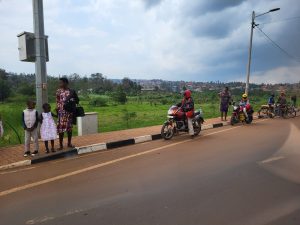HMDT blog: Rwanda before, during and after the genocide
Our Chief Executive, Olivia Marks-Woldman OBE, and our Director of Public Engagement and Deputy Chief Executive, Dr Rachel Century, recently returned from a visit to Rwanda. The trip was organised by Aegis Trust and Ishami Foundation, who also accompanied Olivia and Rachel as they visited memorials and significant sites of the genocide. In our blog, Rachel shares some of the photos she took during her time in Rwanda, and reflects on what they say about the genocide against the Tutsi in Rwanda – before, during and after it took place.

Above image: Kigali Genocide Memorial
Please scroll to the bottom of the page to see the photos that Rachel refers to below and click on each image to see a description and swipe through them.
Before the genocide
Years of tension between the two main ethnic groups in Rwanda, Hutus and Tutsi, were heightened when colonial ruling powers ensured ethnic groups were specified on identity cards. In the run up to the genocide against the Tutsi in Rwanda, which took place in 1994, the tensions increased. In the Kigali Genocide Museum, I was surprised to see a photo of Tutsi students singled out in class, before 1994. This image reminded me of similar images of Jewish children being segregated in Nazi Germany and was a visual reminder of history repeating itself; the 10 stages of genocide repeating. And similar to Nazi Germany, Hutus in Rwanda spread hate propaganda through newspapers, with ‘The Hutu Ten Commandments’ chillingly echoing the Nuremberg laws, specifying that any Hutu who acquires a Tutsi wife is a traitor.
The genocide
After the President’s plane was shot down in April 1994, the genocide against the Tutsi in Rwanda openly started. Neighbours turned on their neighbours, and in some cases, family members killed family members. Many people sought refuge in Churches, hoping that the sacred venue would afford them protection. The Nyamata Church was one such place but, like many others, it proved to be penetrable by the Hutu perpetrators. During the genocide, over just three days, approximately 5,000 people were murdered at the Nyamata Church. It is now a memorial, with the clothes of those murdered there left inside the church. These clothes will never be worn again. The benches and benches of clothes, of all sizes, covered in blood stains, with bullet holes or torn – from machetes – are a stark reminder of their missing owners. Additionally, this church has on display some of the victims’ skulls, a graphic reminder that it wasn’t just clothes that were destroyed in the genocide. This is one way to educate the current population about what has happened, and these skulls confronted us, reminding us of the role of ordinary people – as both victims, murdered for their identity, and as perpetrators.
Rwanda today

Rwanda today
Rwanda today is hustling and bustling, ordinary people go about their daily business, moto taxis drive past in their thousands, markets sell big, colourful fresh fruit. In some ways, the genocide isn’t evident at all, the past is behind and the country is moving on. Yet the genocide decimated the population, as more than 1 million people were murdered, more than 2 million people were accused of being complicit in the genocide and many hundreds of thousands of people fled. It wasn’t as simple as simply putting the past behind and Rwanda is a country that has invested an awful lot in rebuilding.
The Garden of Memory was opened on 11 September 2022, designed by Bruce Clarke, to remember the murdered, honour the survivors, and to educate future generations about what happened in Rwanda. We had the honour and privilege of planting a tree there just a few days after the gardens were inaugurated.
Another way Rwanda is coming to terms with the past is through reconciliation villages. Here, survivors of the genocide live side by side with perpetrators, who have asked their forgiveness. They work alongside each other – in the case of this village, weaving baskets and other items to sell – and by doing so, share stories, share their past, and forge a common bond. In some cases, they even inter-marry. This village was so moving, so inspiring, as we heard from both the perpetrators, and the wives of perpetrators, and the survivors. If they are able to live alongside each other harmoniously, this gives me so much hope for the future.







